Bike Tires: Choosing the right bike tires is key for all cyclists. It doesn’t matter if you ride every day or just occasionally. The right tires impact how well your bike rides, your comfort, and how easily you might get a flat. In this guide, we talk about the important things to think about. This will help you pick the best tires for your rides.
It’s important to know about tire sizes, tread patterns, and valve types. We’ll explain everything. Whether you need tires for a road bike, mountain bike, or commuter bike, we can help. With our tips, you’ll hit the road feeling confident. You’ll know you have the perfect tires on your bike.
Key Takeaways
- Understand the signs that indicate it’s time to replace your bike tires, such as worn-down tread and deteriorating handling.
- Learn how to properly measure and identify the right tire size for your bike, including diameter and width.
- Discover the benefits of wider and narrower tires, and how to choose the optimal width for your riding style and terrain.
- Explore the different tire tread patterns and their intended uses, from smooth road tires to aggressive mountain bike knobs.
- Familiarize yourself with the two main valve types – Presta and Schrader – and their respective advantages.
Signs It’s Time to Replace Your Bike Tires
Staying on top of your bike tires is key for cyclists. If they’re worn, your rides could be less safe and fun. Key signals show when you should get new tires.
Worn-Down Tread
As you use your bike, the tread on the bike tires wears off. This wear makes the tire provide less grip, leading to more flats and less control. Check the tread’s edge often. If it’s very worn, get new tires.
Deteriorated Handling
When the tire tread is too worn, your bike might not handle well. It could feel unsteady or not respond quickly, especially in turns. If you feel like you’re struggling with control, it’s time for new tires.
Visible Tire Distortion
Odd shapes on your tire can mean trouble. These shapes come from a damaged casing. If you see any bulges or lumps, replace your tires right away.
Disappearing Wear Indicators
Some bike tires have special marks that show it’s time to change them. These marks vanish as tire life goes down. If you can’t see these marks, it’s time for new tires.
By watching for these signs, you keep your bike tires top-notch. This brings you the grip, control, and puncture safety you need.
Understanding Bike Tire Sizes
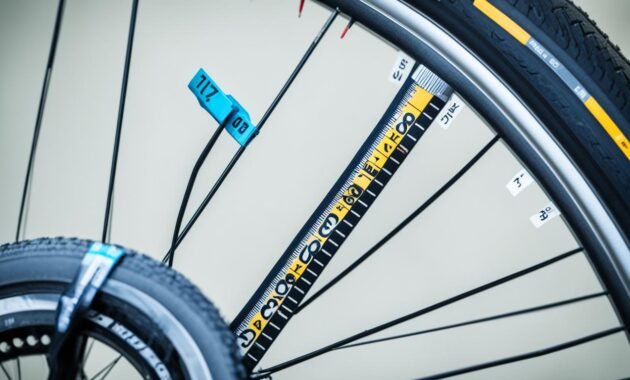
Knowing the right size for your bike tire is key. When looking for new ones, keep in mind there are two key numbers: the tire’s diameter and width. These details are essential, as they tell you how big the tire is.
Diameter and Width Measurements
Tire diameter means the size of the wheel, either in inches or millimeters. Tire width is how wide the tire is across, also in inches or millimeters. Both these numbers show the complete size of your bike tire. This system helps you get the perfect size for your bike.
Mountain Bike Tire Sizes
Mountain bikes usually have bigger tires, from 26 to 29 inches in diameter. Their widths are usually 1.9 to 2.6 inches. These large, knobby tires are great for grip and balance on tough paths.
Road Bike Tire Sizes
Road bikes have smaller tire diameters, around 700c or 29 inches. They are narrower, between 23mm and 32mm wide. This design helps with fast, easy riding on smooth roads.
Kids’ Bike Tire Sizes
Kids’ bike tires vary in size, coming in diameters of 12, 16, 20, and 24 inches. They are usually between 1.75 and 2.125 inches wide. These tires offer a good mix of comfort and control for young riders.
| Bike Type | Tire Diameter | Tire Width |
|---|---|---|
| Mountain Bike | 26 – 29 inches | 1.9 – 2.6 inches |
| Road Bike | 700c (approx. 29 inches) | 23 – 32 mm |
| Kids’ Bike | 12 – 24 inches | 1.75 – 2.125 inches |
Choosing the Right Tire Width
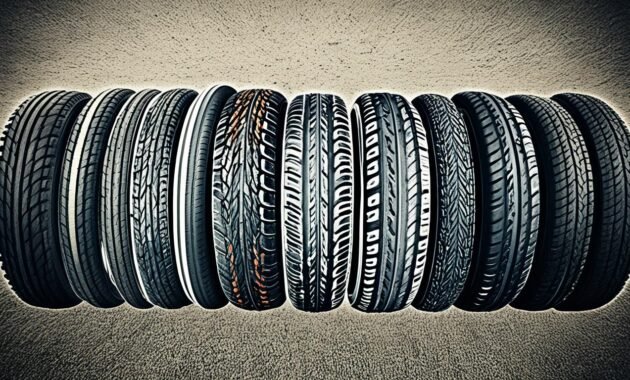
The right bike tire width matters a lot for your ride. You need to match your bike’s diameter exactly. But there’s some play when it comes to width. The size of your tires affects how you ride. So, pick the right width for your bike and where you plan to ride.
Benefits of Wider Tires
Wider bike tires like those on mountain bikes have their perks. They give you better grip and balance, especially on bumpy or soft ground. A wider tire width means more cushion too. This is great for long rides or when the road is not smooth. Plus, wider tires can take more air. So, they help soften the bumps and lower the chance of flat tires.
Benefits of Narrower Tires
But, narrower tires found on road bikes shine in their own ways. They roll easier and faster on flat ground. Lighter tires mean a light bike. It’s then quicker to turn and pick up speed. This setup suits riders who want to go fast and really feel every pedal they take.
Recommended Widths for Different Bike Types
Choosing the best tire width depends on the kind of biking you’ll do. For road bikes, think about 23mm to 28mm, or even up to 32mm for some extra smoothness. Mountain bikes go best with tires from 2.1 to 2.5 inches wide for grip and comfort on rough paths. Gravel bikes find a good middle ground with 32mm to 45mm tires. This range balances speed with handling off-road. Commuter bikes and hybrid bikes do well with 32mm to 38mm. These offer a cozy ride whether on smooth streets or dusty trails.
When rethinking the tire width for your bike, look at what kind of biking you love, the surfaces you’ll meet, and what feels good to you. By picking the right bike tire width, you’ll make your rides better and tailor your tires to be up for your adventures.
Bike Tires
Bike tires are very important for any bike. They affect how well the bike works, how comfortable it is to ride, and how safe it is. Bike tires come in all shapes and sizes, each suited for different conditions. Knowing about these features helps bike riders pick the best tires for them.
The tire case is the tire’s base. It can be made from rubber, nylon, or even strong Kevlar. The outer layer, called the tread pattern, impacts how well the tire grips the road and its performance on various surfaces.
The size of the tire is crucial. Wider tires provide more stability and comfort. Thinner tires are better for being fast because they have less resistance. Also, the tire’s design, such as using special belts or layers that resist punctures, affects how tough the tire is. For people who cycle on roads, mountains, or just to get around, choosing the right bike tires matters a lot. With knowledge about different tire brands and tire features, you can get the ideal wheels for your bike. This makes your riding experience much better.
Understanding Tread Patterns
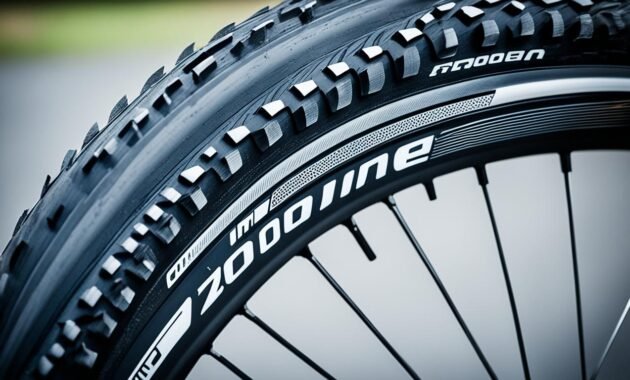
A bike tire’s tread pattern is very important. It decides how well the tire grips different surfaces. Each type of bike, like road bike or mountain bike, has a special tread design for best performance.
Road Bike Tire Treads
Road bike tires usually have a smooth tread. This design is for fast and efficient rides on paved roads. The tires are narrow and have tiny grooves for grip on dry surfaces. With this design, road bikes move quickly and turn easily.
Mountain Bike Tire Treads
Mountain bike tires are quite different. They have a rough, bold pattern that’s great for off-road fun. The big lugs and knobs help the tire grab onto loose or muddy ground. These tires work best on tough trails, giving the rider confidence in any condition.
Gravel Bike Tire Treads
Gravel bike tires are a mix of both road and mountain designs. They have small knobs for grip and smooth parts for faster riding. This design is perfect for roads, gravel, and some off-road tracks. Gravel bikes can handle various terrains because of their smart tread design.
Commuter/Hybrid Bike Tire Treads
Commuter and hybrid bike tires are made for a bit of everything. They have a semi-slick pattern ideal for city streets and light trails. A smooth center helps with fast rides, while the outer tread adds grip. They’re great for daily rides in the city or on smoother paths.
Bike Tire Valve Types
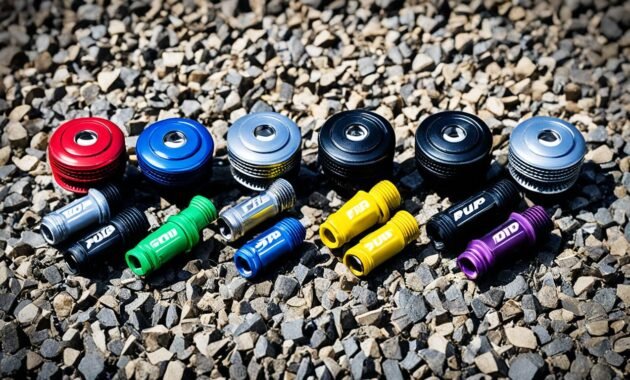
Choosing the right valve when replacing your bike tires is key. There are two common types, Presta and Schrader valves, for bike tire inner tubes and tubeless setups.
Presta Valves
If you have a high-end road or mountain bike, you likely use Presta valves. They’re thin and long. You need a special pump for them. Presta valves work best for precise inflation. This makes them great for performance bikes.
Schrader Valves
On the other hand, Schrader valves are like those on car tires. They’re wider and shorter. You find them on cheaper or kids’ bikes. Schrader valves fit regular air pumps. That’s why many like them, they’re easy to use.
| Feature | Presta Valve | Schrader Valve |
|---|---|---|
| Diameter | Narrower (6mm) | Wider (8mm) |
| Length | Taller (20-30mm) | Shorter (18-20mm) |
| Pump Compatibility | Requires specialized pump head | Can be inflated with standard air compressor |
| Common Usage | Road bikes, mountain bikes | Entry-level bikes, children’s bikes |
Tubeless vs. Tubed Tires
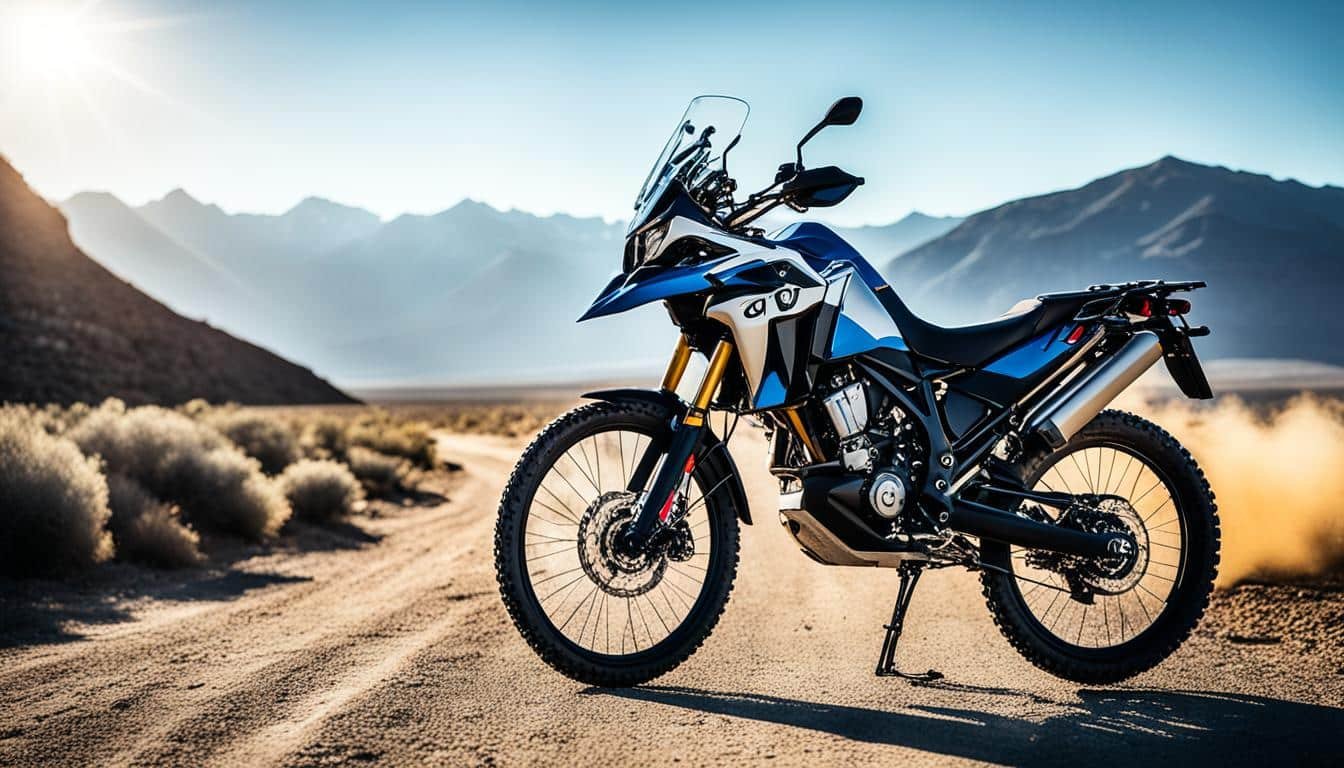
Deciding between tubeless tires and tubed tires is crucial for your bike. Each has its own strengths. The best choice depends on where you ride and what you prefer.
Advantages of Tubeless Tires
Tubeless tires are a favorite for many riders. They offer better puncture protection, more grip, and a smoother journey. They don’t have a tube inside, which lets them match the ground better. This provides more stability and control, especially on tricky surfaces.
Because of this design, you can run tubeless tires at lower air pressures. This improves how comfy they feel under you and how well they corner. But remember, they still roll efficiently.
Tubeless Installation Process
Moving to a tubeless tire setup takes a bit more work. You need to clean the wheel and tire well to get a good seal. You add a special sealant to the tire.
This sealant plugs up small holes as you ride. Then, with a blast from a compressor or a special pump, you lock the tire tight on the rim. This can be harder than fitting a tube, but it pays off over time for a lot of riders.
Puncture-Resistant Bike Tires
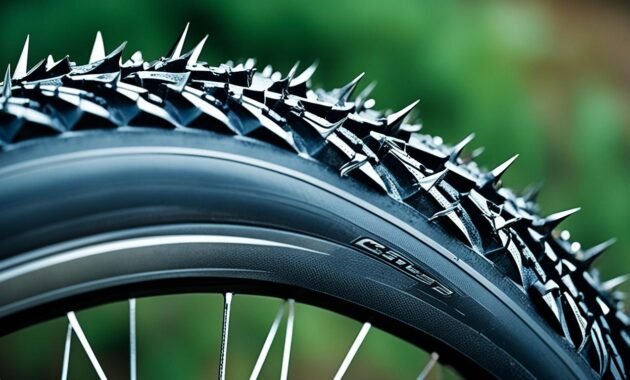
For those who bike a lot and don’t like dealing with flat tires, puncture-resistant tires marathon plus are a great fit. They use stronger rubber, sometimes with Kevlar, and city bike have thicker layers. This means they’re better at stopping things like thorns cross-country best prices from making your tire go flat.
These special tires are built to stop common flat-causing items like thorns and glass. They’re perfect for bike riders who use their bikes daily to get around. Plus, they help cut down on the time and stress of fixing flats.
Not only do they prevent flats, but also they make riding easier. This is because they roll better than regular tires. And that’s good news for anyone who bikes in the city or for fun, looking for a tire that lasts and performs well.
| Feature | Benefit |
|---|---|
| Puncture Resistant Tires | Enhanced protection against flats caused by thorns, glass, and other sharp objects |
| Kevlar Reinforcement | Tougher, more durable construction for increased puncture resistance |
| Thicker Tire Casings | Additional layers of protection against punctures and cuts |
| Low Rolling Resistance | Efficient pedaling and improved overall performance |
Are you a daily rider or just love to bike on weekends? Investing in puncture-resistant mountain and road tires is a smart move. It means you won’t have bike wheels worry about shop for bike tires flats as much. So, you can just enjoy biking without the fear of getting stuck.
Foldable Bike Tires
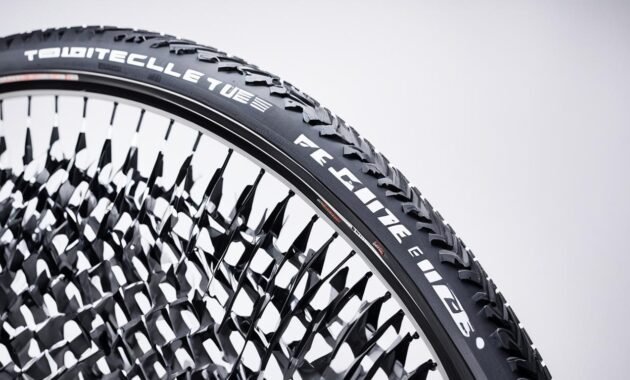
Foldable tires are a great choice for many cyclists. They are perfect for both mountain best possible high-performance and road bikes. These tires have a Kevlar bead, not a wire one. Because of this, they tires for every can be folded or rolled. This feature makes them very portable and easy to carry.
They are light because of the Kevlar bead. This makes them a hit with Riders. They tires for every also last a long time and resist punctures well. For people who ride to tubeless road tire work, travel, or love adventure, foldable tires are a top pick.
Whether you’re going on a trip or just need to save space, foldable bike tires are ideal. They combine easy carrying with top-notch quality. Cyclists who want their ride to be aggressive tread design tires for sale both convenient and smooth will love these tires.
| Feature | Benefit |
|---|---|
| Foldable/Portable Design | Easy to transport and store, ideal for commuters and travelers |
| Kevlar Bead Construction | Provides weight savings and enhanced puncture resistance |
| Versatile Performance | Suitable for a wide range of terrains, from paved roads to light off-road |
Knowing about foldable bike tires helps cyclists choose wisely. These tires meet needs shop for bike tires for convenience, lasting power, and a good ride. They’re a mountain and road smart top brands best possible choice for any cruiser bike tires cyclist. Whether you ride for best mountain fun or for your daily travel, consider fat bike tires these smart tire options.
Also Read : Master BMX Tips And Tricks For Beginners
Conclusion
Choosing the right bike tires is critical for top-notch performance, comfort, and avoiding punctures. Think about tire size, width, tread pattern, valve type, and construction. This helps cyclists pick the best ones for their bike and how they ride.
Whether you ride on roads, in mountains, or to work, picking tires is key. Watch for signs it’s time for new ones. Learn about the choices and select what suits you best. This ensures your tires help you ride better by offering good grip, lasting long, and avoiding flats.
Your tires and how you manage their upkeep can really affect how much you enjoy cycling. Taking the time to find the right tires matters a lot. It lets you fully enjoy biking and tackle any road or trail, feeling sure about your ride.
FAQs
Q: How do I choose the right bike tires for my needs?
A: When choosing bike tires, consider factors such as the type of riding you do (road, mountain, etc.), tire size, tread pattern, and durability. Look for reputable brands like Schwalbe, Maxxis, Continental, or Vittoria that offer a wide selection to suit your specific needs.
Q: What are some popular road tire brands to consider?
A: Some popular road tire brands include Continental, Schwalbe, Vittoria, and Pirelli. These brands offer high-performance tires with various features to enhance your road cycling experience.
Q: What are the differences between clincher and tubular bike tires?
A: Clincher tires are the most common type and feature a bead that hooks onto the rim, while tubular tires are glued to special rims. Clincher tires are easier to repair and replace, while tubular tires are known for their smoother ride and lower rolling resistance.
Q: How do I choose the right mountain bike (MTB) tires?
A: When selecting MTB tires, consider the terrain you ride on most frequently (hardpack, rocky, muddy, etc.), tire width (e.g., 2.0, 2.125), tread pattern for optimal traction, and whether you prefer tubeless or clincher tires.
Q: What are some top brands for MTB tires?
A: Some top brands for MTB tires include Maxxis, Continental, Schwalbe, WTB, and Kenda. These brands offer a wide range of tires suitable for various terrains and riding styles.
Q: How important is tire sealant for tubeless road tires?
A: Tire sealant is crucial for tubeless road tires as it helps seal punctures instantly, allowing you to continue riding without worrying about flat tires. Make sure to check and refill the sealant periodically to maintain its effectiveness.
Q: What are some features to look for in high-performance bike tires?
A: High-performance bike tires often feature lightweight construction, advanced rubber compounds like Addix, aggressive tread designs for optimal traction, puncture protection layers, and low rolling resistance for a faster ride.
Source Links
- https://www.thebikeshoppe.com/articles/how-to-choose-bike-tires-pg1496.htm
- https://www.mec.ca/en/explore/how-to-choose-bike-tires
- https://www.rei.com/learn/expert-advice/bike-tires.html